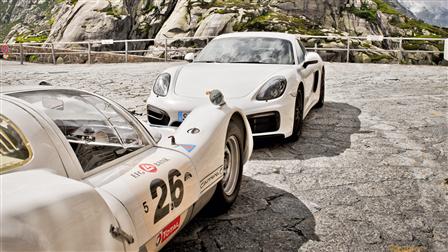
Peak Performer
Climbing into the
A
Let’s be honest: Mid-engine sports cars have never been hotter. The
Two generations ago the car’s power and driving performance would have been enough to virtually guarantee victory at the 24 Hours of Le Mans. If today’s youth can feel like the winners back then, it is thanks to a level of electronic sophistication that smartphones and PCs cannot even dream of. Modern sports cars are prototypes of an electronic system that always works—during any season, in any weather, on all roads, and at any speed.
The two-liter sixcylinder boxer engine is cooled by a fan at the front and aspirated with open induction pipes.
But even these control units pale in comparison with the super-intelligent systems conceived by
This setup for connoisseurs makes it easy to exceed all manner of limits in the car. You can glide serenely through stunning landscape at 121 km/h, but this daredevil violation of 1 km/h above the speed limit is enough to make you an outlaw in Switzerland. Nevertheless, the GTS exudes a deep sense of relaxation. You’re ambling along in sixth gear, with rpm and fuel consumption dipping to ever lower levels, in the luxurious purism of an Alcantara® interior. The decorative seams and insignia stand out in a contrasting hue, the face of the rev counter is all in red, and the decorative trim is made of carbon fiber.
![[+]](https://files.porsche.com/filestore/image/multimedia/none/rd-2014-christophorus-issue369-article10-content-05/normal/46f79fb3-a315-11e4-b849-001a64c55f5c/porsche-normal.jpg)
The road over the 2,224- meter Susten Pass was built between 1938 and 1945. A short straight stretch near the border to the canton of Uri gives the sports cars some room to stretch their legs
The restored
Before this idyllic scene can slip into kitsch, we leave the Swiss autobahn shortly before the Gotthard Tunnel. The road up into the heavens has the qualities of the old hill-climbing routes, with one side being a sheer rocky wall and the other an abyss.
Pressing the Sport Plus button injects an additional surge of adrenaline and testosterone and immediately sharpens the suspension and engine further. The
You’ve hardly deemed the
Weighing less than 700 kilograms, a
![[+]](https://files.porsche.com/filestore/image/multimedia/none/ffd3f99f-c13d-4009-998f-0757ab9848c1/normal/714dbb37-a315-11e4-b849-001a64c55f5c/porsche-normal.jpg)
And then this 918 Spyder suddenly appeared, silently at first, using electric power, and then accompanied by the thunder of its V8 engine.
You glide into a
Our
Stefan Bogner: Born in 1968, Bogner has a passion for photographing breathtaking curves. Preferably in combination with breathtaking cars. And both preferably purist, just like his work. His collections fill volumes, the latest of which is entitled Epic.
The empty roads, clearly visible all the way down into the valley, automatically show an elegant ideal line that would also work well for the postal service buses that travel them regularly. The
Striking four-point headlights suddenly signal the arrival of another extremely capable mountain climber. The curve has hardly straightened out when a
Text by Eckhard Eybl
Photos by Stefan Bogner
Gallery.
906
![[+]](https://files.porsche.com/filestore/image/multimedia/none/rd-2014-christophorus-currentissue-article10-marginal-01/normal/c3bbe61d-6594-11e4-99aa-001a64c55f5c/porsche-normal.jpg)
![[+]](https://files.porsche.com/filestore/image/multimedia/none/rd-2014-christophorus-issue369-article10-marginal-02/normal/c3bbe621-6594-11e4-99aa-001a64c55f5c/porsche-normal.jpg)
![[+]](https://files.porsche.com/filestore/image/multimedia/none/rd-2014-christophorus-issue369-article10-marginal-03/normal/cab53918-6594-11e4-99aa-001a64c55f5c/porsche-normal.jpg)
![[+]](https://files.porsche.com/filestore/image/multimedia/none/rd-2014-christophorus-issue369-article10-marginal-04/normal/f5aa7ea2-68c0-11e4-99aa-001a64c55f5c/porsche-normal.jpg)








